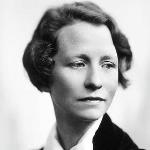 Edna St. Vincent Millay (1892-1950) was an American poet and playwright. Saucy, independent, and openly bisexual, Millay was known for her unconventional Bohemian lifestyle, feminist activism, and many love affairs. Her poetry collection, A Few Figs from Thistles (1920), drew controversy for its novel exploration of female sexuality and feminism. In 1923, her fourth volume of poems, The Ballad of the Harp-Weaver, won the Pulitzer Prize for Poetry. Poet Richard Wilbur said Millay “wrote some of the best sonnets of the century,” and English author Thomas Hardy said that America had two great attractions: The skyscraper and the poetry of Edna St. Vincent Millay. On her death, The New York Times described Millay as “an idol of the younger generation during the glorious early days of Greenwich Village . . . One of the greatest American poets of her time.”
Edna St. Vincent Millay (1892-1950) was an American poet and playwright. Saucy, independent, and openly bisexual, Millay was known for her unconventional Bohemian lifestyle, feminist activism, and many love affairs. Her poetry collection, A Few Figs from Thistles (1920), drew controversy for its novel exploration of female sexuality and feminism. In 1923, her fourth volume of poems, The Ballad of the Harp-Weaver, won the Pulitzer Prize for Poetry. Poet Richard Wilbur said Millay “wrote some of the best sonnets of the century,” and English author Thomas Hardy said that America had two great attractions: The skyscraper and the poetry of Edna St. Vincent Millay. On her death, The New York Times described Millay as “an idol of the younger generation during the glorious early days of Greenwich Village . . . One of the greatest American poets of her time.”
“My candle burns at both ends / it will not last the night
But ah, my foes, and oh, my friends / it gives a lovely light!”
—Edna St. Vincent Millay, “First Fig” from A Few Figs from Thistles, 1920
16 poems















